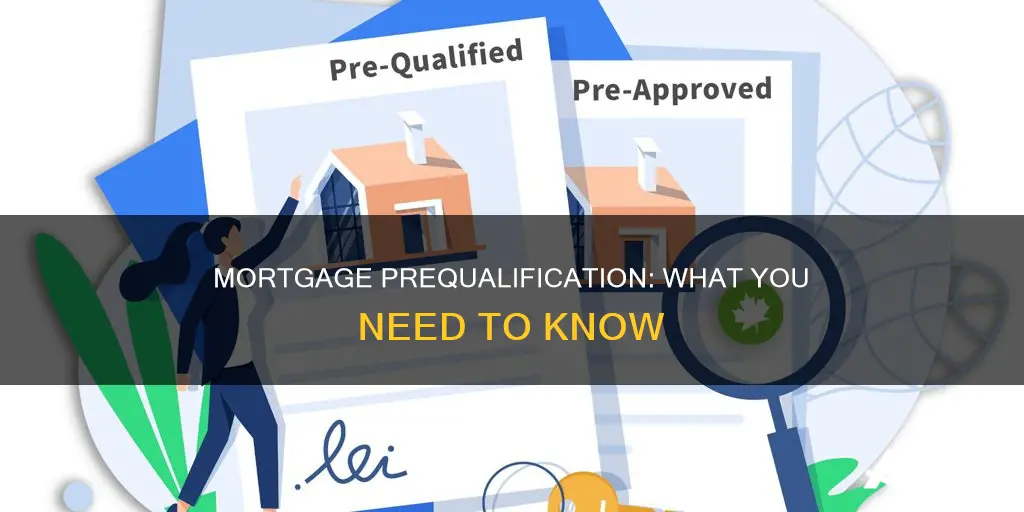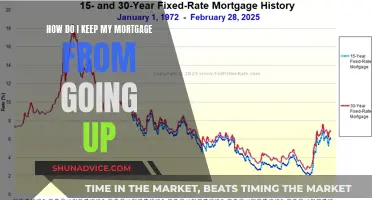
If you're thinking of buying a home, you may want to get prequalified for a mortgage. This is an informal evaluation of your creditworthiness and how much home you can afford based on self-reported information like your credit, debt, income and assets. It's a quick and simple way to find out how much you could borrow and can be done online, in person or over the phone. You'll need to provide some basic information about your income, debts and assets, and the lender will use this to estimate the amount they may be willing to lend you. Prequalification is a good first step in the homebuying process and can help you understand your financial readiness to buy a home. It's also an opportunity to learn about different mortgage options and work with your lender to identify the right fit for your needs and goals.
What You'll Learn

Prequalification vs preapproval
When applying for a mortgage, you may be asked to get prequalified or preapproved. While these terms are sometimes used interchangeably, they have distinct meanings and purposes.
Prequalification
Prequalification is an early step in your homebuying journey. It is a quick and simple way to find out how much you could borrow. It is an informal evaluation of your creditworthiness and how much home you can afford based on self-reported information like your credit, debt, income, and assets. It is a preliminary estimate of the mortgage size you could qualify for. Prequalification is also an opportunity to learn about different mortgage options and work with your lender to identify the right fit for your needs and goals. It can be completed easily and conveniently online, in person, or over the phone in just a few minutes with basic information like your income and expected down payment. No documents or fees are required for a mortgage prequalification, and it does not affect your credit score.
Preapproval
Preapproval is a more official step that requires the lender to verify your financial information and credit history. It is a more specific estimate of what you could borrow from your lender and requires documents such as your W2, pay stubs, tax returns, and your Social Security card. Preapproval demonstrates a more serious step towards homeownership and lets sellers know that you already qualify for home financing, which greatly increases your chance of having your offer selected. You will receive a preapproval letter to supply to sellers, indicating that a lender has verified your financial information and that you can afford a mortgage. It is as close as you can get to confirming your creditworthiness without having a purchase contract in place.
Who Holds Your Mortgage? A Guide to Finding Out
You may want to see also

How to get prequalified
Prequalification is an early step in the home-buying process. It is an informal evaluation of your creditworthiness and how much home you can afford. It is based on self-reported information like your credit, debt, income, and assets. It is a quick and simple way to find out how much you could borrow.
To get prequalified, you can reach out to a lender to start the process. You can do this online, in person, or over the phone. You will need to provide some basic information about your income, debts, and assets. The financial information is typically self-reported, and the lender usually does not verify it. However, some lenders may run a soft credit check, which will not affect your credit score. Be honest about the information you provide so that you receive an accurate home loan estimate.
After you have provided the necessary information, the lender will issue a pre-qualification letter with the estimated home loan amount they are willing to lend you. It is important to note that pre-qualification is not a guarantee of a loan, but it is a great way to understand your financial readiness to buy a home and see which types of loans are available to you.
If you are ready to take the next step, you can get preapproved for a mortgage. This involves providing documentation to verify your income and assets, such as pay stubs, tax records, and proof of assets. Preapproval gives a more specific estimate of what you can borrow and demonstrates a more serious step towards homeownership.
Recognizing Tracker Mortgages: What You Need to Know
You may want to see also

Prequalification requirements
Firstly, prequalification is based on an informal evaluation of your creditworthiness and how much home you can afford. This is determined by self-reported information about your credit, debt, income, and assets. Lenders will use this information to estimate the amount they may be willing to lend you. It is important to be honest when providing this information, as it will help you receive a more accurate estimate.
Secondly, while prequalification does not require documentation or fees, some lenders may perform a "'soft'" credit inquiry to obtain information about your credit history and monthly debts. This is different from a "'hard'" credit inquiry, which is a detailed investigation that requires your permission and is usually carried out during preapproval.
Thirdly, prequalification is a quick process that can be completed online, over the phone, or in person. It is often free and does not impact your credit score, even if you decide to repeat the process.
Finally, prequalification is not a guarantee of a loan, but rather an estimate of your potential borrowing amount. It is a good first step to understanding your financial readiness to buy a home and exploring different mortgage options.
Finding Your Wells Fargo Mortgage Account Number: A Guide
You may want to see also

Preapproval requirements
Preapproval for a mortgage is a more involved process that is best suited to borrowers who are ready and motivated to buy. It is a more accurate and reliable estimate of how much a lender is willing to lend you, based on a more complete view of your credit. It is also an opportunity to learn about different mortgage options and work with your lender to identify the right fit for your needs and goals.
To get preapproved, you will need to supply more information than you would for prequalification, and the application is likely to take more time. You should receive your preapproval letter within 10 business days after you’ve provided all requested information.
The requirements for preapproval are:
- Proof of income: Lenders need to know that you have a stable income that can service mortgage payments on a regular basis. You may need to provide two to three months of retirement account statements, including 401(k)s and IRAs.
- Employment verification: Lenders will want to see that you have been employed continuously for at least two years. You will need to provide contact information for any employers you’ve had within the past two years. Some companies have an employment verification phone number for lenders.
- Tax forms: You will need to provide your W-2 tax form and 1099s if you have additional income sources and pay stubs. Self-employed applicants will likely have to provide two years of income tax returns.
- Social Security number: You will need to provide your Social Security number, as well as that of any co-borrower.
- Bank and investment account information: Lenders will want to see your bank and investment account statements to prove that you have funds for a down payment, closing costs, and cash reserves.
- Documentation: Lenders will need to see documentation of your debts, assets, and credit score and history. This includes your credit report, as well as any other important financial documentation.
Freddie Mac: Who Owns Your Mortgage and How to Know?
You may want to see also

How to get preapproved
Getting preapproved for a mortgage is a more in-depth process than prequalification. It involves providing proof of your debt, income, assets, and credit score and history. It is a more accurate and reliable estimate of how much you can borrow. Here are the steps to get preapproved:
Step 1: Gather the necessary documentation
You will need to provide documentation to support your application. This includes Social Security numbers, proof of income (such as pay stubs and tax forms), banking information, and address history. If you have any additional sources of income, such as investments or a side hustle, be prepared to provide documentation for those as well. Lenders typically prefer to see two years of continuous employment, but there are exceptions for self-employed applicants, who may need to provide two years of tax returns.
Step 2: Verify your financial information
Before you can get preapproved, you will need to verify your financial information. This includes information about your income, debt, and financial accounts. You may also need to provide information about your employment status and any recurring debt payments. Lenders will use this information to assess your debt-to-income ratio.
Step 3: Understand the credit check process
A preapproval requires a "hard" credit inquiry, which provides a detailed view of your credit history. This may cause a slight, temporary drop in your credit score, but multiple inquiries from mortgage lenders within 30 days typically won't affect your score. It's a good idea to check your credit score before applying; a score of at least 620 is recommended to qualify for a mortgage.
Step 4: Contact a lender
You will need to contact a lender to get preapproved. It's worth contacting multiple lenders to compare offers, as this can help you find the best rates and save money over the life of your mortgage.
Step 5: Receive your preapproval letter
After submitting all the required information, you should receive a preapproval letter within 3-10 business days. This letter is valid for 60-90 days and can be shared with real estate agents and home sellers to demonstrate that you are a serious buyer.
It's important to note that preapproval does not guarantee a loan, and you will still need to get full approval once you find a property. Additionally, preapproval does not require you to borrow the full amount offered, and it's important to only borrow what you are comfortable with.
Who Owns Your Mortgage Now? Find Out
You may want to see also
Frequently asked questions
Mortgage pre-qualification is an informal evaluation of your creditworthiness and how much home you can afford based on self-reported information like your credit, debt, income, and assets. It is a quick and simple way to find out how much you could borrow.
The first step to get pre-qualified for a mortgage is to speak with a lender. You will need to provide some basic information about your income, debts, and assets. No documents are required for a mortgage prequalification.
Pre-approval is a more accurate and reliable estimate based on a more complete view of your credit. It involves providing documentation of everything you reported in your pre-qualification and a hard credit pull. Pre-approval demonstrates a more serious step towards homeownership.
Pre-qualification is a great way to get a general idea of your home-buying budget and to learn about different mortgage options. It is also an opportunity to work with your lender to identify the right fit for your needs and goals.
After pre-qualification, you will usually receive a “pre-qualification letter” that you can show to an agent or seller as proof of what you may be able to afford. You can then decide to get pre-approved, which will increase your chances of having your offer selected.







